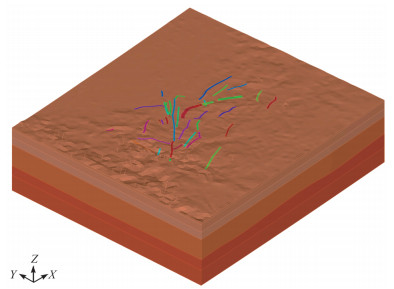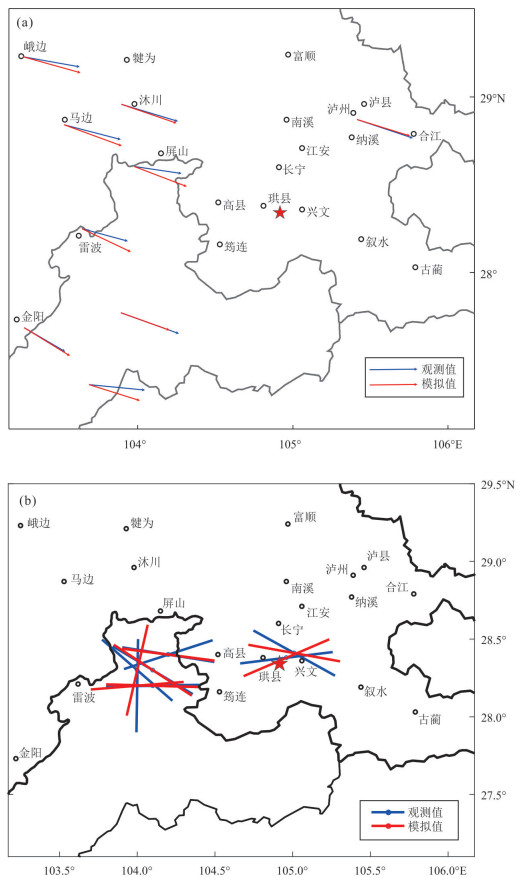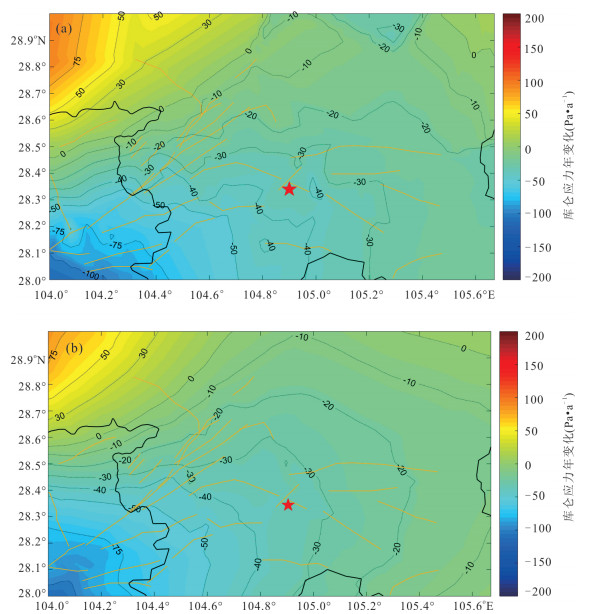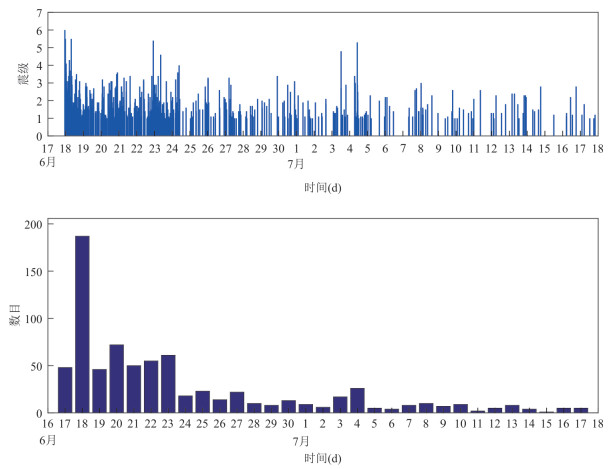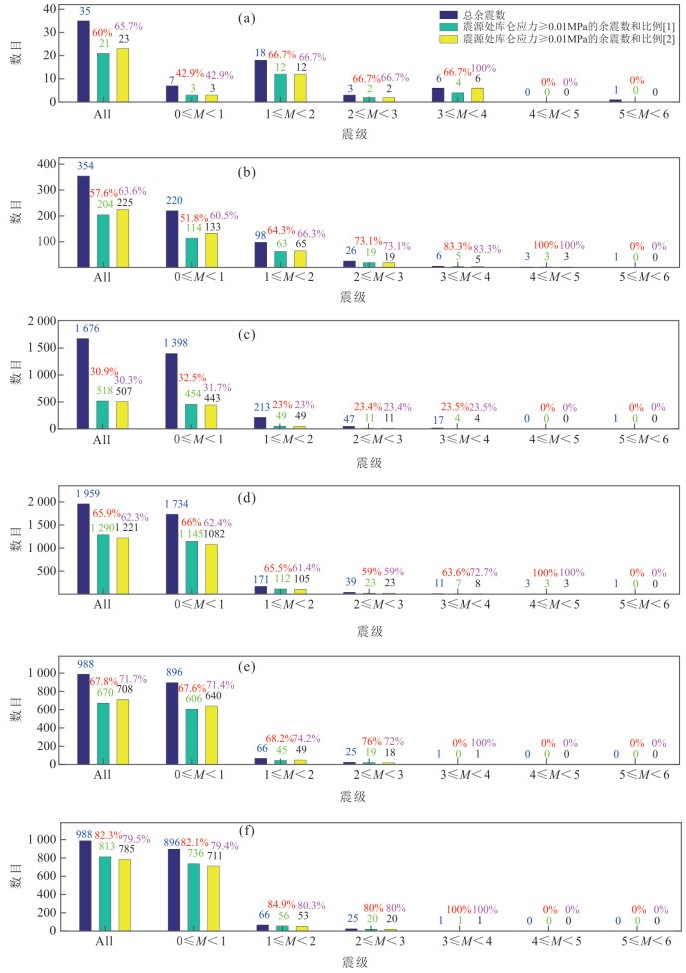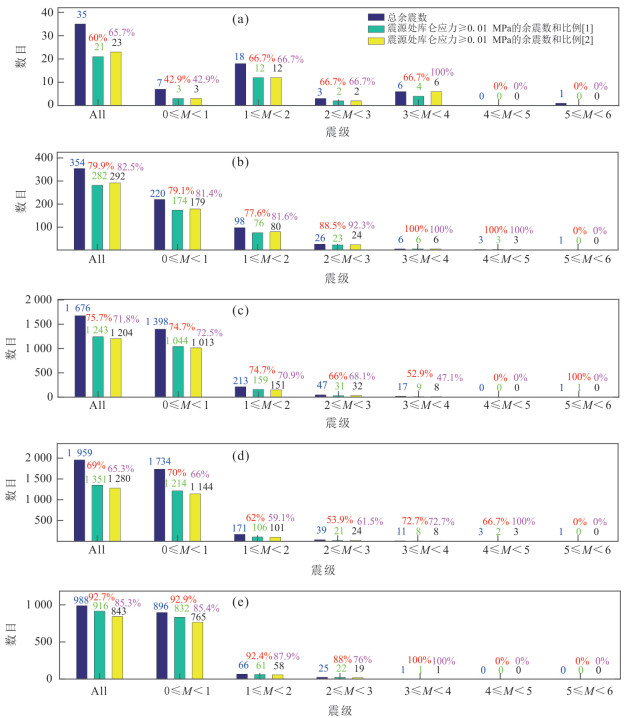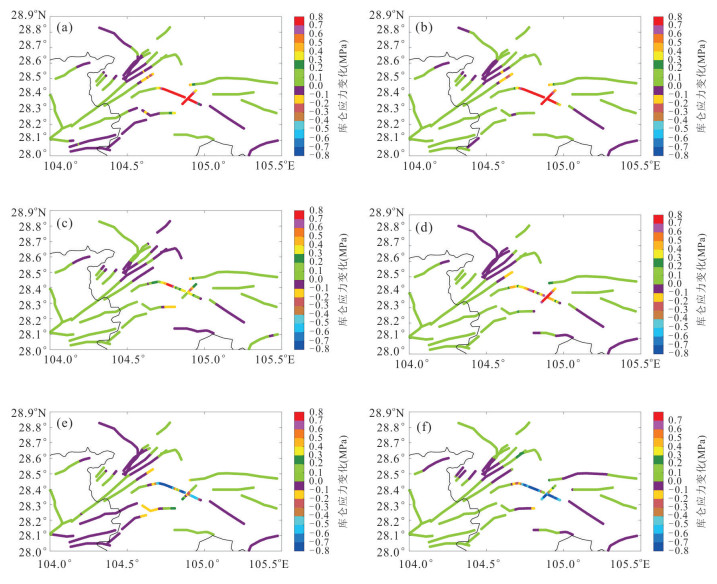Relationship between Stress Evolution and Aftershocks after Changning M 6.0 Earthquake in Sichuan on 17 June, 2019
-
摘要: 2019年6月17日四川长宁县发生6.0级地震,该次地震余震活动频度高、强度大,其中超过5.0级的强余震就有4次,具有不同于以往6.0级地震的独特特征.余震活动与震后区域应力变化密切相关,为研究它们之间的关系,考虑区域主要活动构造、地表起伏和深部反演结果,建立长宁地区岩石圈三维黏弹性有限元模型.采用数值方法重建基本符合研究区GPS观测和最大水平主压应力方向测量结果的现今构造背景应力场.进而依次模拟了长宁6.0级地震和5.0级以上强余震序列.通过计算库仑破裂应力变化研究了震后应力演化与余震分布,以及主震和5.0级强余震序列之间的关系.研究表明,长宁6.0级地震的发生可能与区域内非构造加载因素有关,余震活动明显受震后区域应力变化的控制.长宁地震后,于滩-长宁背斜在10 km深度应力得到充分释放,库仑破裂应力明显减小;而在3 km深度库仑破裂应力明显增加,应力水平仍然较高.Abstract: On 17 June, 2019, an M 6.0 earthquake occurred in Changning County, Sichuan Province, with high aftershock activity frequency and intensity. And among the aftershocks, there are 4 strong ones with M≥5.0, which is different from the previous M 6.0 earthquakes. The aftershock activity is closely related to the regional stress change after the mainshock. In order to study the relationship between them, a 3D viscoelastic finite element model of the lithosphere in the Changning area is established. In the model, the main active structures, topographic relief and deep inversion results were considered. By using numerical method, the present tectonic background stress field in the study area is reconstructed to conform to the GPS observed value and the measured one of maximum horizontal principal compressive stress direction. Then the Changning M 6.0 earthquake and its strong aftershock sequence with M≥5.0 were simulated sequentially. The relationship between the stress evolution and aftershocks, as well as the mainshock and the strong aftershock sequence with M≥5.0 were studied by calculating the Coulomb failure stress. The results show that the occurrence of the Changning M 6.0 earthquake may be independent with the regional tectonic loading factors, and the aftershock activity is obviously controlled by the regional stress change after the mainshock. After the Changning earthquake, the stress at the depth of 10 km in the Yutan-Changning anticline was fully released, and the Coulomb failure stress decreased significantly. However, at the depth of 3 km, the Coulomb failure stress increases obviously and the stress level is still high.
-
图 1 2019年6月17日长宁6.0级地震序列重定位结果及邻区的主要活动构造
主要活动构造数据由中国地震局地震预测研究所李文巧和熊仁伟提供,黑色实线为背斜,灰色实线为向斜,红色实线为活动断裂;长宁6.0级地震及5.0级以上余震重定位结果见易桂喜等(2019);长宁6.0级地震余震重定位结果由中国地震局地球物理研究所杨婷提供(个人通讯)
Fig. 1. Relocation results of the Changning M6.0 earthquake sequence on June 17, 2019 and the main active structures in Changning area and its vicinity
图 6 长宁地区库仑破裂应力年变化
a.震源机制解取胡晓辉等(2020)的结果;b.震源机制解取易桂喜等(2019)的结果;红色五角星表示长宁6.0级地震的震中位置
Fig. 6. Annual variation of Coulomb failure stress in the Changning area
图 7 长宁地区断裂带上库仑破裂应力年变化
a.震源机制解取胡晓辉等(2020)的结果;b.震源机制解取易桂喜等(2019)的结果
Fig. 7. Annual variation of Coulomb failure stress on faults in the Changning area
图 9 主震和强余震的同震库仑破裂应力变化与余震分布之间的关系
a.长宁6.0地震,长宁6.0级地震后至珙县5.1级地震前的余震;b.珙县5.1级地震,珙县5.1级地震后至长宁5.3级地震前的余震;c.长宁5.3级地震,长宁5.3级地震后至珙县5.4级地震前的余震;d.珙县5.4级地震,珙县5.4级地震后至珙县5.6级地震前的余震;e.珙县5.6级地震,珙县5.6级地震后至2019年7月17日的余震;f.珙县5.4级地震和珙县5.6级地震,珙县5.6级地震后至2019年7月17日的余震;图例中[1]表示采用胡晓辉等(2020)震源机制解,[2]表示采用易桂喜等(2019)震源机制解
Fig. 9. Relationship between the coseismic Coulomb failure stress change and aftershock distribution
图 10 主震和强余震的总库仑破裂应力变化与余震分布之间的关系
a.长宁6.0地震后,长宁6.0级地震后至珙县5.1级地震前的余震;b.珙县5.1级地震后,珙县5.1级地震后至长宁5.3级地震前的余震;c.长宁5.3级地震后,长宁5.3级地震后至珙县5.4级地震前的余震;d.珙县5.4级地震后,珙县5.4级地震后至珙县5.6级地震前的余震;e.珙县5.6级地震后,珙县5.6级地震后至2019年7月17日的余震;图例中[1]表示采用胡晓辉等(2020)震源机制解,[2]表示采用易桂喜等(2019)震源机制解
Fig. 10. Relationship between the total Coulomb failure stress changes and aftershock distribution
图 11 震后断裂带库仑应力变化
a.3 km深度;b.3 km深度;c.5 km深度;d.5 km深度;e.10.7 km深度;f.10.7 km深度;其中a,c,e采用胡晓辉等(2020)震源机制解,d,e,f采用易桂喜等(2019)震源机制解
Fig. 11. Coulomb failure stress changes in fault zones after earthquake
表 1 长宁地震序列震源机制解
Table 1. Focal mechanism solution of Changning earthquake sequence
序号 时间(年-月-日)/地点 经度(°) 纬度(°) 深度(km) 走向(°) 倾角(°) 滑动角(°) 震级(Ms) 震级(Mw) 资料来源 1 2019-06-17长宁 104.90 28.34 10.7 309 68 41 5.8 胡晓辉等(2020) 104.905 28.344 3 131 51 36 6.0 5.79 易桂喜等(2019) 2 2019-06-17珙县 104.77 28.43 2.4 309 73 56 5.0 胡晓辉等(2020) 104.805 28.418 2 311 60 45 5.1 4.99 易桂喜等(2019) 3 2019-06-18长宁 104.87 28.38 5.8 133 34 90 4.4 胡晓辉等(2020) 104.869 28.368 3 164 24 111 5.3 4.74 易桂喜等(2019) 4 2019-06-22珙县 104.77 28.43 4.2 191 25 110 5.3 胡晓辉等(2020) 104.793 28.424 2 170 31 71 5.4 5.08 易桂喜等(2019) 5 2019-07-04珙县 104.74 28.41 8.2 129 37 90 5.1 胡晓辉等(2020) 104.74 28.41 7 165 41 79 5.6 5.02 易桂喜等(2019) 表 2 长宁6.0级地震主震及强余震破裂参数及模拟结果
Table 2. Rupture parameters and simulation results of mainshock and strong aftershocks of the Changning M 6.0 earthquake
序号 时间(年-月-日) 地点 震级(Ms) 地表下破裂长度(km) 平均位错(km) 模拟值(km) 1 2019-06-17 长宁 6.0 11.482 0.550 0.549 0 2 2019-06-17 珙县 5.1 3.451 0.466 0.467 0 3 2019-06-18 长宁 5.3 4.508 0.483 0.483 7 4 2019-06-22 珙县 5.4 5.152 0.492 0.492 0 5 2019-07-04 珙县 5.6 6.730 0.511 0.513 4 表 3 长宁6.0级主震和5.0级强余震序列震中位置之间的距离
Table 3. The distance between epicenters of the Changning M 6.0 mainshock and the strong aftershock with M≥5.0
地震序号 震中位置之间的距离(km) 2 3 4 5 1 12.93 4.47 14.27 17.95 2 8.47 1.37 6.50 3 9.81 13.63 4 5.48 表 4 长宁6.0级主震和5.0级强余震序列前序地震在后继地震位置的库仑破裂应力变化
Table 4. Coulomb failure stress changes at the epicenter of the strong aftershock with M≥5.0
后继地震 前序地震导致的在后继地震位置的库仑破裂应力变化(MPa) 震源机制数据 1长宁6.0级 2珙县5.1级 3长宁5.3级 4珙县5.4级 总库仑应力 2珙县5.1级 -0.057 7 -0.057 7 胡晓辉等(2020) -0.166 3 -0.166 3 易桂喜等(2019) 3长宁5.3级 0.342 9 -0.022 6 0.320 3 胡晓辉等(2020) 0.616 6 -0.071 3 0.545 3 易桂喜等(2019) 4珙县5.4级 -0.058 6 -0.057 4 -0.066 5 -0.182 5 胡晓辉等(2020) -0.067 5 -0.102 0 -0.080 2 -0.249 7 易桂喜等(2019) 5珙县5.6级 -0.006 8 0.253 0 -0.002 8 0.429 8 0.673 2 胡晓辉等(2020) 0.047 0 0.492 1 0.058 4 0.739 2 1.336 7 易桂喜等(2019) -
Deng, J. S., Sykes, L. R., 1997a. Evolution of the Stress Field in Southern California and Triggering of Moderate-Size Earthquakes: A 200-Year Perspective. Journal of Geophysical Research: Solid Earth, 102(B5): 9859-9886. https://doi.org/10.1029/96jb03897 Deng, J. S., Sykes, L. R., 1997b. Stress Evolution in Southern California and Triggering of Moderate-, Small-, and Micro-Size Earthquakes. Journal of Geophysical Research: Solid Earth, 102(B11): 24411-24435. https://doi.org/10.1029/97jb02127 Harris, R. A., 1998. Introduction to Special Section: Stress Triggers, Stress Shadows, and Implications for Seismic Hazard. Journal of Geophysical Research: Solid Earth, 103(B10): 24347-24358. https://doi.org/10.1029/98jb01576 He, D. F., Lu, R. Q., Huang, H. Y., et al., 2019. Tectonic and Geological Setting of the Earthquake Hazards in the Changning Shale Gas Development Zone, Sichuan Basin, SW China. Petroleum Exploration and Development, 46(5): 1051-1064(in Chinese with English abstract). doi: 10.1016/S1876-3804(19)60262-4 Heidbach, O., Rajabi, M., Cui, X. F., et al., 2018. The World Stress Map Database Release 2016: Crustal Stress Pattern across Scales. Tectonophysics, 744: 484-498. https://doi.org/10.1016/j.tecto.2018.07.007 Hu, X. H., Sheng, S. Z., Wan, Y. G., et al., 2020. Study on Focal Mechanism and Post-Seismic Tectonic Stress Field of the Changning, Sichuan, Earthquake Sequence on June 17th, 2019. Progress in Geophysics, 35(5): 1675-1681 (in Chinese with English abstract). Hu, X. P., Cui, X. F., Zhang, G. W., et al., 2021. Analysis on the Mechanical Causes of the Complex Seismicity in Changning Area, China. Chinese Journal of Geophysics, 64(1): 1-17(in Chinese with English abstract). King, G. C. P., Stein, R. S., Lin, J., 1994. Static Stress Changes and the Triggering of Earthquakes. Bulletin of the Seismological Society of America, 84(3): 935-953. Lei, X. L., Su, J. R., Wang, Z. W., 2020. Growing Seismicity in the Sichuan Basin and Its Association with Industrial Activities. Scientia Sinica (Terrae), 50(11): 1505-1532(in Chinese). doi: 10.1360/N072020-0045 Li, P. G., Liao, L., Feng, J. Z., 2019. The Relationship between Stress Changes and Strong Earthquakes since 1900 around the Bayan Har Block in Northern Tibet, China. Journal of Asian Earth Sciences, 184: 103974. https://doi.org/10.1016/j.jseaes.2019.103974 Li, Y. H., Gao, M. T., Wu, Q. J., 2014. Crustal Thickness Map of the Chinese Mainland from Teleseismic Receiver Functions. Tectonophysics, 611: 51-60. https://doi.org/10.1016/j.tecto.2013.11.019 Li, Y. H., Wu, Q. J., Pan, J. T., et al., 2013. An Upper-Mantle S-Wave Velocity Model for East Asia from Rayleigh Wave Tomography. Earth and Planetary Science Letters, 377-378: 367-377. https://doi.org/10.1016/j.epsl.2013.06.033 Li, Y. J., Chen, L. W., Liu, S. F., et al., 2015. Coseismic Coulomb Stress Changes Caused by the Mw6.9 Yutian Earthquake in 2014 and Its Correlation to the 2008 Mw7.2 Yutian Earthquake. Journal of Asian Earth Sciences, 105: 468-475. https://doi.org/10.1016/j.jseaes.2015.02.025 Liao, L., Li, P. E., Yang, J. S., et al., 2019. The Stress Evolution before the 2013 M7.0 Lushan Earthquake in the Longmen Shan Area since 1900. Journal of Geodynamics, 125: 1-12. https://doi.org/10.1016/j.jog.2019.01.016 Liu, J. G., Wan, Y. G., Huang, Z. B., et al., 2019. Study on Central Focal Mechanism and Its Surrounding Tectonic Stress Field of the Changning M6.0 Earthquake in Sichuan. Technology for Earthquake Disaster Prevention, 14(3): 677-685 (in Chinese with English abstract). Luo, G., Liu, M., 2010. Stress Evolution and Fault Interactions before and after the 2008 Great Wenchuan Earthquake. Tectonophysics, 491(1-4): 127-140. https://doi.org/10.1016/j.tecto.2009.12.019 Parsons, T., Ji, C., Kirby, E., 2008. Stress Changes from the 2008 Wenchuan Earthquake and Increased Hazard in the Sichuan Basin. Nature, 454: 509-510. https://doi.org/10.1038/nature07177 Shan, B., Xiong, X., Zheng, Y., et al., 2013. Stress Changes on Major Faults Caused by 2013 Lushan Earthquake and Its Relationship with 2008 Wenchuan Earthquake. Scientia Sinica (Terrae), 43(6): 1002-1009(in Chinese). doi: 10.1360/zd-2013-43-6-1002 Shao, Z. G., Zhou, L. Q., Jiang, C. S., et al., 2010. The Impact of Wenchuan Ms8.0 Earthquake on the Seismic Activity of Surrounding Faults. Chinese Journal of Geophysics, 53(8): 1784-1795(in Chinese with English abstract). Shen, Z. K., Wan, Y. G., Gan, W. J., et al., 2003. Viscoelastic Triggering among Large Earthquakes along the East Kunlun Fault System. Chinese Journal of Geophysics, 46(6): 786-795(in Chinese with English abstract). Shi, Y. L., Cao, J. L., 2008. Effective Viscosity of China Continental Lithosphere. Earth Science Frontiers, 15(3): 82-95(in Chinese with English abstract). doi: 10.1016/S1872-5791(08)60064-0 Sichuan Changning M6.0 Earthquake Investigation Team, 2020. Scientific Investigation Report on the Changning M 6.0 Earthquake in Sichuan Province. Changning, 23-24(in Chinese). Stein, R. S., Barka, A. A., Dieterich, J. H., 1997. Progressive Failure on the North Anatolian Fault since 1939 by Earthquake Stress Triggering. Geophysical Journal International, 128(3): 594-604. https://doi.org/10.1111/j.1365-246X.1997.tb05321.x Stein, R. S., King, G. C., Lin, J., 1992. Change in Failure Stress on the Southern San Andreas Fault System Caused by the 1992 Magnitude=7.4 Landers Earthquake. Science, 258(5086): 1328-1332. https://doi.org/10.1126/science.258.5086.1328 Stein, R. S., Lisowski, M., 1983. The 1979 Homestead Valley Earthquake Sequence, California: Control of Aftershocks and Postseismic Deformation. Journal of Geophysical Research: Solid Earth, 88(B8): 6477-6490. https://doi.org/10.1029/jb088ib08p06477 Sun, Y. J., Dong, S. W., Fan, T. Y., et al., 2013.3D Rheological Structure of the Continental Lithosphere beneath China and Adjacent Regions. Chinese Journal of Geophysics, 56(9): 2936-2946(in Chinese with English abstract). Toda, S., Lin, J., Meghraoui, M., et al., 2008.12 May 2008 M=7.9 Wenchuan, China, Earthquake Calculated to Increase Failure Stress and Seismicity Rate on Three Major Fault Systems. Geophysical Research Letters, 35(17): L17305. https://doi.org/10.1029/2008gl034903 Wan, Y. G., Wu, Z. L., Zhou, G. W., et al., 2000. "Stress Triggering" between Different Rupture Events in Several Earthquakes. Acta Seismologica Sinica, 22(6): 568-576(in Chinese with English abstract). Wang, Y. Z., Wang, F., Wang, M., et al., 2014. Coulomb Stress Change and Evolution Induced by the 2008 Wenchuan Earthquake and Its Delayed Triggering of the 2013 Mw 6.6 Lushan Earthquake. Seismological Research Letters, 85(1): 52-59. https://doi.org/10.1785/0220130111 Wells, D. L., Coppersmith, K. J., 1994. New Empirical Relationships among Magnitude, Rupture Length, Rupture Width, Rupture Area, and Surface Displacement. Bulletin of the Seismological Society of America, 84(4): 974-1002. Xu, Z. G., Liang, S. S., Sheng, S. Z., et al., 2020. Relocation and Source Characteristics of the 2019 Changning Ms 6.0 Earthquake Sequence. Acta Seismologica Sinica, 42(4): 377-391, 509(in Chinese with English abstract). Yi, G. X., Long, F., Liang, M. J., et al., 2019. Focal Mechanism Solutions and Seismogenic Structure of the 17 June 2019 Ms 6.0 Sichuan Changning Earthquake Sequence. Chinese Journal of Geophysics, 62(9): 3432-3447(in Chinese with English abstract). Zhang, P. Z., 2008. Recent Tectonic Deformation, Strain Partitioning and Deep Dynamic Processes in the Eastern Margin of Tibetan Plateau, Western Sichuan Area. Science in China: Earth Sciences, 38(9): 1041-1056(in Chinese). 何登发, 鲁人齐, 黄涵宇, 等, 2019. 长宁页岩气开发区地震的构造地质背景. 石油勘探与开发, 46(5): 993-1006. https://www.cnki.com.cn/Article/CJFDTOTAL-SKYK201905021.htm 胡晓辉, 盛书中, 万永革, 等, 2020.2019年6月17日四川长宁地震序列震源机制与震源区震后构造应力场研究. 地球物理学进展, 35(5): 1675-1681. https://www.cnki.com.cn/Article/CJFDTOTAL-DQWJ202005006.htm 胡幸平, 崔效锋, 张广伟, 等, 2021. 长宁地区复杂地震活动的力学成因分析. 地球物理学报, 64(1): 1-17. doi: 10.3969/j.issn.1672-7940.2021.01.001 雷兴林, 苏金蓉, 王志伟, 2020. 四川盆地南部持续增长的地震活动及其与工业注水活动的关联. 中国科学: 地球科学, 50(11): 1505-1532. https://www.cnki.com.cn/Article/CJFDTOTAL-JDXK202011001.htm 刘敬光, 万永革, 黄志斌, 等, 2019.2019年6月17日四川长宁6.0级地震中心震源机制解及震源区构造应力场研究. 震灾防御技术, 14(3): 677-685. https://www.cnki.com.cn/Article/CJFDTOTAL-ZZFY201903019.htm 单斌, 熊熊, 郑勇, 等, 2013.2013年芦山地震导致的周边断层应力变化及其与2008年汶川地震的关系. 中国科学: 地球科学, 43(6): 1002-1009. https://www.cnki.com.cn/Article/CJFDTOTAL-JDXK201306008.htm 邵志刚, 周龙泉, 蒋长胜, 等, 2010.2008年汶川Ms 8.0地震对周边断层地震活动的影响. 地球物理学报, 53(8): 1784-1795. doi: 10.3969/j.issn.0001-5733.2010.08.004 沈正康, 万永革, 甘卫军, 等, 2003. 东昆仑活动断裂带大地震之间的黏弹性应力触发研究. 地球物理学报46(6): 786-795. doi: 10.3321/j.issn:0001-5733.2003.06.010 石耀霖, 曹建玲, 2008. 中国大陆岩石圈等效粘滞系数的计算和讨论. 地学前缘, 15(3): 82-95. doi: 10.3321/j.issn:1005-2321.2008.03.006 四川长宁6.0级地震科学考察队, 2020. 四川长宁6.0级地震科学考察报告. 长宁, 23-24. 孙玉军, 董树文, 范桃园, 等, 2013. 中国大陆及邻区岩石圈三维流变结构. 地球物理学报, 56(9): 2936-2946. https://www.cnki.com.cn/Article/CJFDTOTAL-DQWX201309008.htm 万永革, 吴忠良, 周公威, 等, 2000. 几次复杂地震中不同破裂事件之间的"应力触发"问题. 地震学报, 22(6): 568-576. doi: 10.3321/j.issn:0253-3782.2000.06.002 徐志国, 梁姗姗, 盛书中, 等, 2020.2019年四川长宁Ms 6.0地震序列重定位和震源特征分析. 地震学报, 42(4): 377-391, 509. https://www.cnki.com.cn/Article/CJFDTOTAL-DZXB202004001.htm 易桂喜, 龙锋, 梁明剑, 等, 2019.2019年6月17日四川长宁Ms 6.0地震序列震源机制解与发震构造分析. 地球物理学报, 62(9): 3432-3447. https://www.cnki.com.cn/Article/CJFDTOTAL-DQWX201909017.htm 张培震, 2008. 青藏高原东缘川西地区的现今构造变形、应力分配与深部动力学过程. 中国科学: 地球科学, 38(9): 1041-1056. doi: 10.3321/j.issn:1006-9267.2008.09.001 -









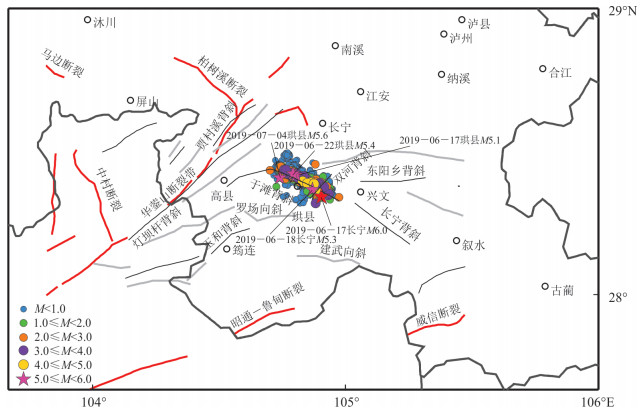
 下载:
下载:
